Knowing these 9 Things about Tibetan Culture, You'll Travel Tibet like a Local
Tibet boasts a time-honored and rich culture, which attracts many tourists from other places. While among various features of Tibet culture, I think the most significant ones could be the 9 facts listed as follows. Check these facts to know well about Tibet culture, and you will travel to Tibet like a local.
 1. Tibetan New Year is the Most Significant Event for Tibetan People
1. Tibetan New Year is the Most Significant Event for Tibetan People
 2. Most Tibetan Locals Do the Kora Every Morning and Evening
2. Most Tibetan Locals Do the Kora Every Morning and Evening
 4. All Monasteries and Temples are the Most Holiest Architecture for All Tibetans
4. All Monasteries and Temples are the Most Holiest Architecture for All Tibetans
 5. All Tibetans Need to Learn the Tibetan Language from Preschool
5. All Tibetans Need to Learn the Tibetan Language from Preschool
 7. All Tibetan People are Eating Meat, including Lamas and Monks
7. All Tibetan People are Eating Meat, including Lamas and Monks
 8. Tea House is the Most Popular Place for Tibetans
8. Tea House is the Most Popular Place for Tibetans
1. Tibetan New Year is the Most Significant Event for Tibetan People
Just like Christmas for western people, the Tibetan New Year is the most significant event of the year for us. Also known as Losar, it is the most important traditional festival in Tibet, begins on the first day of the first month in the Tibetan Calendar.
In fact, before Tibetan New Year, we are ready busy with kinds of preparations. Every family will do house cleaning, and the hostess will cook new year dishes like Guthuk, a special hand-rolled noodle soup.
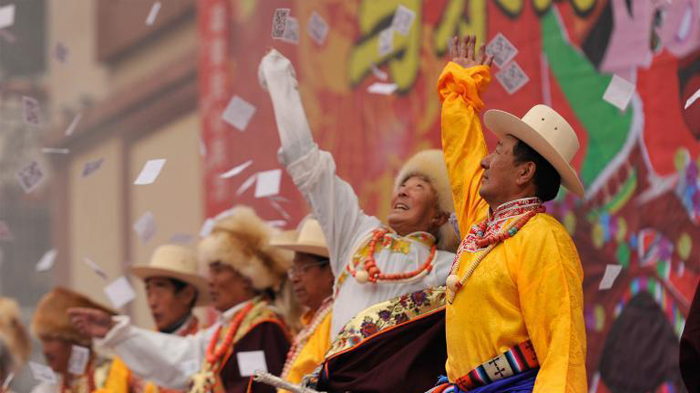 Locals gather together to celebrate Tibetan New Year.
Locals gather together to celebrate Tibetan New Year.
During the festival, all Tibetans will attend various activities to celebrate this grand event. We will take a family praying ceremony, have a family reunion dinner, visit local monasteries for worship, hang new prayer flags, etc. Also, we dance and sing together to enjoy this great moment of the year.
2. Most Tibetan Locals Do the Kora Every Morning and Evening
Kora is the most common practice of Tibetan Buddhism and can be seen everywhere in Tibet. Normally, we do the kora by walking and praying in a clockwise direction around monasteries, mountains, lakes, or other sacred sites.
But you may not know that most Tibetans do the kora in the morning and evening. This is because the sunshine is not that strong during these periods. On a plateau with an average altitude of 4,000 meters, Tibet has many sunny days, with thin air and strong ultraviolet rays.
 Do the kora is an everyday ritual for Tibetans.
Do the kora is an everyday ritual for Tibetans.
Also, we think it is more divine to complete the kora in the morning and evening. In the early morning of Lhasa, many of us will walk the path around Jokhang Temple, while shaking prayer wheels and chanting scriptures.
3. Every Wednesday and Friday All Tibetan Buddhists Will Try Not to Eat Meat and Do More Religious Activities
In Tibet, all lamas and monks are allowed to eat meat. But on Wednesdays and Fridays, all Tibetan Buddhists will try not to eat meat. It is a tradition and custom inherited from generation to generation.
In fact, Tibetan Buddhism never promotes or commends the habit of eating meat, and even more strictly forbids killing living creatures. But since Tibet is provided with an extreme environment and harsh climate, lack of vegetables and fruits, and we have to eat meat to stop hunger and keep out the cold.
So as Tibetan Buddhists, we choose to be vegetarian on certain days. Meanwhile, we will do more religious activities like sermon, chanting, pilgrimage, reciting precepts, etc.
4. All Monasteries and Temples are the Most Holiest Architecture for All Tibetans
According to the statistics, there are over 1700 temples in Tibet. Where there are people living, there are temples located, as the center of the region. The monasteries and temples, no matter how big or small, are the holiest architectures in our hearts.
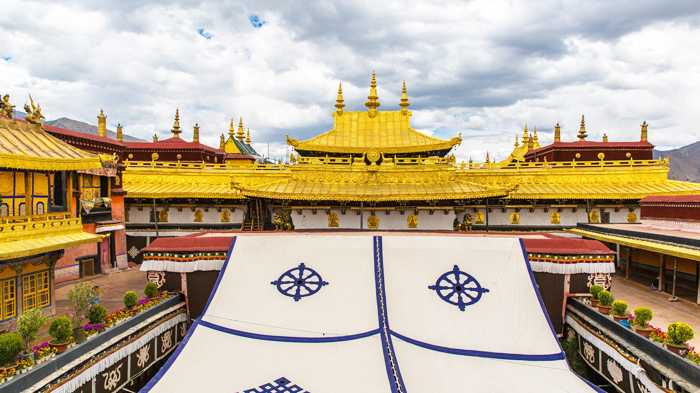 Jokhang Temple is the spiritual center of Tibet and the holiest destination for all Tibetan pilgrims.
Jokhang Temple is the spiritual center of Tibet and the holiest destination for all Tibetan pilgrims.
In Lhasa and Shigatse, there are famous monasteries like Jokhang Temple, Drepung Monastery, Tashilunpo Monastery, attracting hundreds of pilgrims every year. They not only serve as the Buddhist academies, but also hold religious ceremonies during major festivals.
While many small temples also play an important position. Like Samye Monastery in Shannan, it is the first temple in Tibet. Rongbuk Monastery, at a high elevation of 5154m, is a unique temple accepting both monks and nuns, and also a perfect site to view Mount Everest.
5. All Tibetans Need to Learn the Tibetan Language from Preschool
Tibetans have always attached great importance to the preservation and transmission of the traditional culture. That’s why we will let our kids learn the Tibetan language from an early age, normally from preschool.
By learning our own language well, we believe that we can become a person with dignity and confidence, and have more emotional connection with other companions. In this way, we can truly understand our own Tibetan culture and history.
6. Most Tibetan People Wear Their Own Costumes while Young Generations Like Jeans for Work Convenience
Most of us wear our own costumes in our daily lives. The traditional Tibetan clothing is generally characterized by the long robe, the shirt of various patterns, and a colorful apron tied in front of the waist. In addition, there are always many decorated accessories like necklaces, belts, earrings, etc.
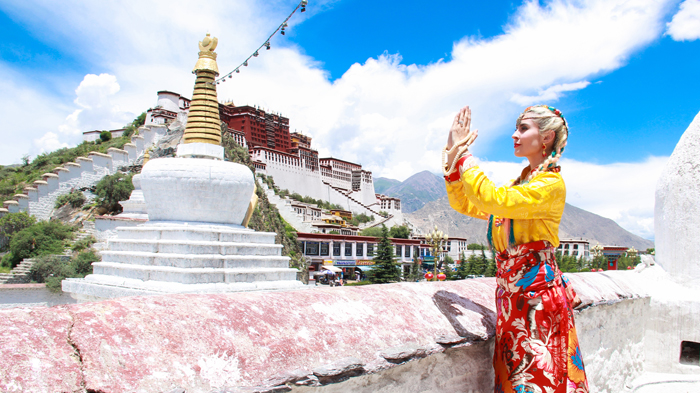 We can help you if you want to dress traditional Tibetan clothing during your Tibet tour.
We can help you if you want to dress traditional Tibetan clothing during your Tibet tour.
While nowadays, young generations tend to dress more casually for working convenience. They will wear jeans, sportswear, suits, jackets, etc., just like most people living in mainland China. There are also more casual fashion shops to be found on the streets of Lhasa. But during the festival celebration, all of us will wear traditional costumes.
7. All Tibetan People are Eating Meat, including Lamas and Monks
All Tibetans, including lamas and monks, are eating meat in daily diets, although we believe in Buddhism. However, we usually do not eat fish, as well as donkey meat, horse meat, or dog meat.
We have the custom of water burial. As fish are scavenging creatures, we believe that the flesh of our ancestors was eaten by fish. Eating fish is the same as eating the flesh of our ancestors, so we do not eat fish.
Besides, we are very grateful to the creatures that have favors for ourselves. Dogs are loyal caretakers to us, helping to graze yaks and sheep. And mules, donkeys, horses likewise help us a lot.
8. Tea House is the Most Popular Place for Tibetans
In Tibet, the tea house is the most commonly visited place for us to pass time. It can be seen everywhere and even in remote villages of Tibet. Here, we can have a good rest, meet with friends or relatives, or get the latest information we need.
Many of us go to tea house every day even earlier than go to work. Especially in the dry winter, drinking a cup of sweet tea can both moisturize the lip and keep oneself warm. There is often the old man on the way of kora rest here, enjoying tea, while chanting the sutra and turning the prayer wheels in the hand.
9. We Have One Festival in Every Month
If you want to enjoy a festival tour in Tibet, you will have many chances. As there is almost one festival to celebrate each month, and sometimes even several in a single month.
 Kailash Saga Dawa Festival is one of the Four Major Festivals of the Tibetan calendar.
Kailash Saga Dawa Festival is one of the Four Major Festivals of the Tibetan calendar.
All Tibetan festivals are based on the Tibetan calendar and are usually celebrated in different activities. For example, during Saga Dawa Festival (May 31, 2022), we will do kora around Mount Kailash. And when celebrating the Shoton Festival (Aug. 27, 2022), the most important ritual will be the unfolding of giant Thangka paintings.
Conclusion
In addition to these major facts mentioned above, you can have more to explore about the Tibetan culture. Whether you are interested in Tibetan festivals, religious customs, food, and dining, or local Buddhist architectures, you can contact us to learn more. And If you join in our Tibet cultural tour of the well-designed itinerary, you can experience the local culture firsthand, in the company of our knowledgeable local guide.

The Lhasa-born prodigy used to study business overseas, and got his Bachelor of Business in Nepal and India before moving back to his homeland. With pure passion for life and unlimited love for Tibet, Kunga started his guide career as early as 1997.
Responsible, considerate, and humorous, he devoted his entire life to guiding and serving international tourists traveling in Tibet. As a legendary Tibetan travel guru with 20-year pro guide experience. Currently, he is working in Tibet Vista as the Tour Operating Director. Whenever our clients run into trouble, he is your first call and will offer prompt support.
Related Articles & Posts
Most Popular Tibet Tour Packages
-

Lhasa - Gyantse - Shigatse - Everest Base Camp - Shigatse - Lhasa
USD939
View Details -

Lhasa - Gyantse - Shigatse - E.B.C - Saga - Kailash Trek - Darchen - Lake Manasarovar - Saga - Gyirong - Tingri - Lhasa
USD2059
View Details -

10 Days Lhasa to Everest Base Camp and Namtso Lake Small Group Tour
Lhasa - Gyantse - Shigatse - EBC - Shigatse - Lhasa - Namtso Lake - Damxung - Lhasa
USD1289
View Details -

8 Days Driving Across Himalaya Overland Adventure from Kathmandu to Lhasa
Kathmandu - Gyirong - Everest Base Camp - Tingri - Shigatse - Gyantse - Lhasa
USD1069
View Details -

4 Days Lhasa Impression Small Group Tour: Explore the Heart of Tibet and Mingle with the Locals
Lhasa
USD509
View Details -

Lhasa - Gyantse - Shigatse - Everest Base Camp - Gyirong - Kathmandu
USD979
View Details -

Lhasa - Gyantse - Shigatse- Lhasa
USD799
View Details -

13 Day Lhasa, Mt. Everest, Mt. Kailash, Lake Manasarovar and Kathmandu Adventure Tour
Lhasa - Gyantse - Shigatse - EBC - Saga - Darchen - Kailash Trek - Darchen - Saga - Gyirong - Kathmandu
USD2059
View Details


.jpg)



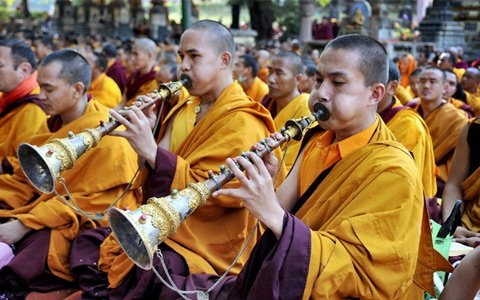

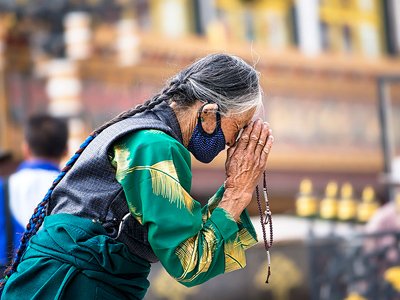
.jpg)